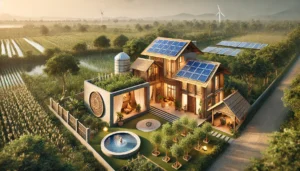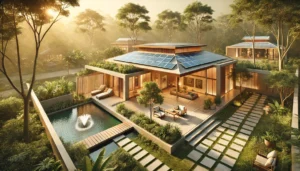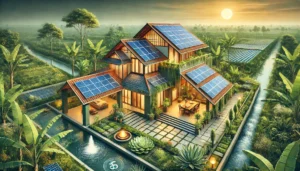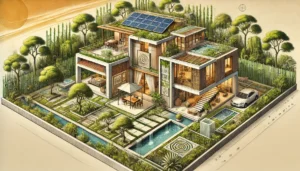
vastu Shastra
How to Build an Eco-Friendly Home Inspired by Vastu Shastra
The modern world’s growing environmental consciousness has fostered a significant interest in sustainable living. One ancient practice, Vastu Shastra, provides a unique blueprint for harmonizing architecture with nature. By blending its principles with eco-friendly innovations, you can create a home that is not only in harmony with the environment but also promotes health, prosperity, and positive energy. This article explores how to build an eco-friendly home inspired by Vastu Shastra in great detail.
Understanding Vastu Shastra: A Primer
Vastu Shastra, the ancient Indian science of architecture and design, emphasizes creating living spaces that align with the laws of nature. Rooted in the five elements—earth (prithvi), water (jal), fire (agni), air (vayu), and space (akash)—it provides guidelines for constructing homes that harness positive energies and maintain balance with the environment.
When combined with eco-friendly practices, Vastu Shastra can help create homes that reduce carbon footprints, conserve resources, and promote holistic well-being.
Table of Contents
Key Principles of Eco-Friendly Vastu Homes
Location and Orientation
Eco-Friendly Aspect: Choose a plot in a naturally ventilated, green area away from industrial pollution and noise.
Vastu Integration: Ensure the home faces east or northeast to maximize sunlight, improving energy efficiency and promoting health. Avoid plots near stagnant water or excessive shade, as they can harbor negative energies.
Material Selection
Eco-Friendly Aspect: Use sustainable and locally sourced materials like bamboo, reclaimed wood, mud bricks, and stone.
Vastu Integration: Earth-friendly materials resonate with the element of prithvi, ensuring the home is grounded and stable.
Design Layout
Eco-Friendly Aspect: Incorporate open spaces, courtyards, and skylights for natural light and air circulation.
Vastu Integration: Follow the principles of the mandala to position rooms and structures harmoniously. For instance:
Living rooms in the northeast for vibrant energy.
Bedrooms in the southwest for stability.
Kitchens in the southeast, aligned with the fire element.
Water Management
Eco-Friendly Aspect: Install rainwater harvesting systems and graywater recycling units to conserve water.
Vastu Integration: Place water features in the northeast to enhance prosperity and harmony, as water symbolizes wealth in Vastu.
Energy Efficiency
Eco-Friendly Aspect: Use solar panels, energy-efficient lighting, and appliances.
Vastu Integration: Ensure the rooftop is free of unnecessary clutter and direct sunlight flows into essential areas, maximizing the fire element’s benefits.
Green Spaces
Eco-Friendly Aspect: Create gardens with native plants, organic vegetables, or medicinal herbs.
Vastu Integration: Place gardens in the north or east to enhance positive energy. Avoid planting large trees in the south or west to prevent energy blockages.

vastu shastra
Step-by-Step Guide to Building an Eco-Friendly Vastu Home
Step 1: Site Selection
Choose a plot with fertile soil, natural slopes for water drainage, and abundant sunlight.
Avoid plots with sharp angles or irregular shapes, as these disrupt the energy flow.
Step 2: Planning and Design
Zoning and Room Placement
Use Vastu’s directional principles to place rooms strategically:
North/Northeast: Meditation rooms, gardens, or water tanks.
East: Entry points and living spaces.
Southeast: Kitchens to align with the fire element.
Southwest: Bedrooms for grounding and stability.
Keep the center of the home open (Brahmasthan) to facilitate the flow of energy.
Natural Ventilation and Lighting
Use large windows and ventilators on the northern and eastern sides to harness natural light and fresh air.
Design high ceilings to promote air circulation and thermal comfort.
Sustainable Insulation
Opt for eco-friendly insulation materials like cork, recycled wool, or hemp.
Use light-colored paints and reflective coatings to minimize heat absorption.
Step 3: Construction Materials and Techniques
Eco-Friendly Materials
Replace concrete with alternatives like compressed stabilized earth blocks (CSEBs).
Use lime plaster instead of chemical paints for a breathable and toxin-free finish.
Traditional Building Techniques
Adopt methods like rammed earth walls or cob construction for durability and insulation.
Employ artisans familiar with Vastu-compliant designs to maintain traditional aesthetics.
Step 4: Renewable Energy Integration
Install solar panels for electricity and water heating.
Use biogas systems for waste-to-energy conversion, especially in rural setups.
Position solar panels on rooftops in the southeast or south for optimal efficiency.
Step 5: Water Conservation Systems
Incorporate rainwater harvesting systems by connecting rooftop drains to underground storage tanks.
Reuse graywater from bathrooms and kitchens for gardening purposes.
Install drip irrigation systems to minimize water wastage in gardens.
Step 6: Eco-Friendly Interiors
Furniture and Decor
Use furniture made from bamboo, rattan, or recycled wood.
Incorporate handmade, biodegradable decor items like clay pots, jute rugs, or cotton curtains.
Indoor Plants
Place air-purifying plants like snake plants, money plants, or tulsi indoors.
Position them in the northeast or east for positive vibrations.
Natural Cooling and Heating
Use terracotta tiles or stone flooring for natural cooling.
Design verandas or porches for shaded outdoor seating.
The Benefits of Eco-Friendly Vastu Homes
Environmental Sustainability
Reduces reliance on non-renewable resources.
Promotes biodiversity through green spaces and native plantings.
Health and Well-Being
Improves air quality and natural light exposure, boosting physical and mental health.

vastu shastra
Minimizes exposure to toxins and allergens.
Energy Efficiency
Cuts energy consumption through renewable systems and passive cooling/heating techniques.
Harmony and Positivity
Aligns energies within the home to create a serene and prosperous living environment.
Challenges and Modern Solutions
Cost Concerns: While eco-friendly materials can be expensive upfront, their durability and energy efficiency ensure long-term savings.
Availability of Resources: Collaborate with local suppliers and builders experienced in sustainable practices.
Balancing Tradition and Innovation: Use technology like Vastu-compatible software to integrate ancient principles with modern designs seamlessly.
Conclusion
Building an eco-friendly home inspired by Vastu Shastra is more than just constructing a sustainable dwelling—it is about fostering harmony between humanity and nature. By adhering to Vastu principles and embracing eco-friendly practices, you can create a space that not only conserves the planet’s resources but also enhances the quality of life for its occupants.
Whether you are renovating an existing home or starting from scratch, this approach paves the way for a brighter, greener future. In the spirit of Sanatan Dharma, let your home reflect the balance and interconnectedness of all life.

vastu shastra
FAQs for “How to Build an Eco-Friendly Home Inspired by Vastu Shastra”:
- What is Vastu Shastra, and how does it relate to eco-friendly homes?
Vastu Shastra is an ancient Indian architectural science that focuses on harmony between nature, energy, and human living spaces. By incorporating eco-friendly materials and practices, Vastu principles can guide the design of sustainable homes that align with environmental balance.
- What are the key Vastu principles for building a sustainable home?
Orient the house to maximize natural light and ventilation.
Use eco-friendly and locally sourced materials.
Design spaces based on the five elements (earth, water, fire, air, and space).
Focus on energy flow and balance for well-being and sustainability.
- What materials should I use for an eco-friendly home according to Vastu?
Use natural, renewable, and locally available materials like bamboo, stone, clay bricks, wood, lime plaster, and mud. These materials are energy-efficient, durable, and sustainable.
- How can I ensure proper ventilation and natural light in my home?
According to Vastu, position windows and doors strategically in the north and east directions to allow maximum natural light and airflow. Skylights and ventilators can also enhance ventilation while reducing energy consumption.
- What is the ideal orientation of rooms in an eco-friendly Vastu-compliant home?
Living Room: North or East
Kitchen: Southeast (Fire Element)
Bedroom: Southwest for stability and peace
Study Room: Northeast for mental clarity
Bathrooms: Northwest
- How can I incorporate renewable energy into my home as per Vastu?
Install solar panels on the roof (preferably in the south direction for optimal sunlight). Use wind energy if feasible, and ensure these installations do not block sunlight or airflow into the house.
- Does Vastu Shastra recommend rainwater harvesting?
Yes, rainwater harvesting aligns with the water element in Vastu. It supports sustainable water use and enhances the natural energy of the property by preserving resources.
- Are there specific plants recommended for eco-friendly Vastu homes?
Vastu suggests planting tulsi, neem, money plants, and bamboo for good energy and air purification. Trees should be placed in the south or west, while flowering plants can be in the north or east.
- What role does landscaping play in Vastu Shastra and eco-friendly design?
Landscaping connects your home with nature, balancing energy flow. Use water bodies (ponds, fountains) in the northeast and trees or gardens in the southwest. Avoid large trees near the house’s entrance or north side.
- Can I apply Vastu principles in urban apartments?
Yes, even in apartments, you can follow Vastu by optimizing natural light, ventilation, eco-friendly interiors, and energy-efficient appliances. The layout can be adjusted to align with the elements where possible.
- How does Vastu address waste management in eco-friendly homes?
Install composting systems for organic waste.
Place waste segregation units in the northwest direction.
Use eco-friendly materials to reduce non-biodegradable waste generation.
- Is Vastu compatible with modern sustainable architecture?
Absolutely. Both emphasize harmony with nature, efficient use of resources, and enhancing human well-being. Combining Vastu with sustainable practices creates homes that are energy-efficient and spiritually balanced.
- What are common mistakes to avoid while building a Vastu-compliant eco-friendly home?
Ignoring natural ventilation or light.
Using synthetic or harmful materials.
Misaligning rooms with the five elements.
Blocking energy flow with clutter or poor design.
- How does water conservation align with Vastu Shastra?
Place water storage systems or tanks in the northeast direction to harness positive energy. Use greywater recycling systems for irrigation and reduce water waste to stay eco-conscious.
- Can I retrofit my existing home to align with Vastu and eco-friendly principles?
Yes, you can make changes like rearranging furniture, adding plants, improving ventilation, using natural materials, and incorporating renewable energy solutions to align your home with Vastu and eco-friendly practices.
Summary
How to Build an Eco-Friendly Home Inspired by Vastu Shastra:
Building an eco-friendly home rooted in the principles of Vastu Shastra combines ancient architectural wisdom with modern sustainable practices. Here’s a quick guide:
- Site Selection and Orientation
Vastu Principle: Choose a plot with positive energy and align the home to cardinal directions (north, east, south, west).
Eco-Friendly Practice: Opt for land that supports natural drainage and minimizes harm to ecosystems. Design the house to maximize sunlight and natural ventilation.
- Natural Materials
Vastu Principle: Use organic materials like clay, stone, or wood to enhance harmony.
Eco-Friendly Practice: Source sustainable and locally available materials to reduce carbon footprint.
- Energy Efficiency
Vastu Principle: Keep living spaces in alignment with solar and wind directions for better energy flow.
Eco-Friendly Practice: Incorporate passive solar heating, reflective roofing, and energy-efficient appliances to reduce energy consumption.
- Water Conservation
Vastu Principle: Place water elements like tanks or fountains in the northeast for prosperity.
Eco-Friendly Practice: Install rainwater harvesting systems, greywater recycling, and water-efficient fixtures.
- Green Spaces
Vastu Principle: Plant greenery in the northeast or east to attract positive energy.
Eco-Friendly Practice: Develop a kitchen garden or green roofs to improve air quality and support biodiversity.
- Waste Management
Vastu Principle: Avoid clutter and maintain cleanliness for better energy flow.
Eco-Friendly Practice: Implement waste segregation, composting, and recycling for a sustainable lifestyle.
- Airflow and Lighting
Vastu Principle: Ensure windows and doors are placed for proper airflow and natural light.
Eco-Friendly Practice: Use large windows, skylights, and energy-efficient LEDs to reduce reliance on artificial lighting.
By blending Vastu principles with sustainable design, an eco-friendly home ensures harmony with nature while fostering a healthy and energy-efficient living environment.
Related Articles
- Comparison of Ancient and Modern Sports: How Traditional Sports Have Influenced Contemporary Games
- “Timeless Lessons from Ancient Tales: Linking Samudra Manthan and Ganga’s Descent to Modern Ecological Challenges”
- “Reviving Sanskrit: How AI is Preserving Ancient Languages for the Future”
- “Mathura: The Sacred Land of Lord Krishna’s Divine Leelas”
- Investing for Future Generations: Lessons from Indian Traditions on Legacy Building and Wealth Preservation
- “Ancient Indian Wisdom: Timeless Lessons for Tackling Today’s Climate Crisis”
- “Artificial Intelligence and Spirituality: Transforming Ancient Practices for the Modern World”
- “Gold and Real Estate in India: Timeless Assets Shaping Financial Strategies”
- “Divine Feminine Power in Hindu Mythology: The Legends of Durga, Saraswati, and Lakshmi”
- “Divine Beings of Sanatan Dharma: The Spiritual Significance of Sacred Animals in Hinduism”
- “Symbolism in Mythological Art: Unlocking Hidden Meanings in Ancient Temple Carvings”
- “Exploring Technological Advancements in Ancient India and Civilizations: Vimana, Metallurgy, & Water Management systems”
- Unveiling the Mysteries: Ancient Temples of Sanatan Dharma , Mysterious Temples of India
- “The Scientific Knowledge of Sanatan Dharma: Ancient Wisdom Meets Modern Science”
- Ancient Indian Sports and Games: Celebrating a Legacy of Skill, Strength & Strategy”
- “Exploring the Cosmic Link: The Connection Between Astronomy and Vedic Astrology”
- The Power of Sanskrit: Unlocking the Divine Language of the Gods
- “The End of Kaliyuga: A Sanatan Insight into the World’s Final Chapter”
- Explore more articles on Prachin Sanatan Yuga.
